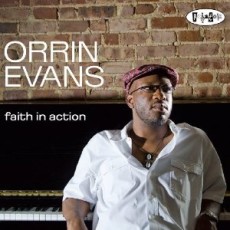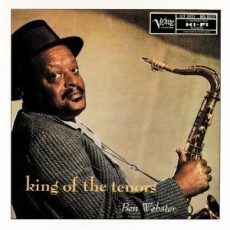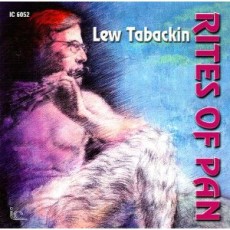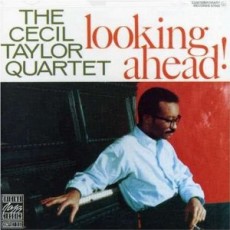
Daily Dose Of Jazz…
Orrin Evans was born on March 28, 1976 in Trenton, New Jersey but was raised in Philadelphia, Pennsylvania. Nurtured in a household filled with music due to his classical singer mother who surrounded him with the melodies of Puccini to the pulsating rhythms of Basie and Ellington.
Evans graduated from high school in the early 90s and studied at Rutgers University before going on to study piano privately with Kenny Barron and be employed as a sideman by Bobby Watson, Ralph Peterson, Duane Eubanks, Lenora Zenzalai-Helms and others.
Evans recorded his first session as a leader, The Orrin Evans Trio, for his own Black Entertainment label in 1994. After that, he signed with Criss Cross and between 1997-99 he recorded Justin Time, Captain Black and Grown Folks Bizness. Into the new millennium Orrin recorded prolifically releasing “Listen to the Band”, “Blessed Ones” and “Meant to Shine”, continuing his yearly release schedule up to his latest “Flip The Script”.
Influenced greatly by McCoy Tyner, Horace Silver, Bud Powell and Thelonious Monk among others, he remains in the hard bop genre but occasionally detours into soul-jazz and R&B when backing vocalists Denise King and Dawn Warren. In 2010 he was awarded a Pew Fellowship in the Arts. He continues to perform, record and tour.

Daily Dose Of Jazz…
Benjamin Francis Webster was born on March 27, 1909 in Kansas City, Missouri and learned to play piano and violin at an early age, before learning to play the saxophone, although he did return to the piano from time to time, even recording on the instrument occasionally. But it was Budd Johnson who showed him some basics on the saxophone. Webster began to play that instrument in the Young Family Band that at the time included Lester Young.
Kansas City at this point was a melting pot from which emerged some of the biggest names in 1930s jazz and Webster spent time with the Andy Kirk orchestra, joined Bennie Moten’s legendary 1932 band that included Count Basie, Oran Page and Walter Page, Fletcher Henderson’s Orchestra, then Benny Carter, Willie Bryant, Cab Calloway and the Teddy Wilson orchestras.
Also known as “The Brute” or “Frog”, Ben was an influential jazz tenor saxophonist who had a tough, raspy, and brutal tone on stomps (with his own distinctive growls), yet on ballads he played with warmth and sentiment. Stylistically he was indebted to alto star Johnny Hodges, who, he said, taught him to play his instrument.
By the mid thirties he was playing with the Duke Ellington Orchestra as the featured tenor on recordings of Cotton Tail and All Too Soon. His contribution to the band, along with bassist Jimmy Blanton, was so important that Ellington’s orchestra during that period is known as the Blanton-Webster band.
After Ellington in 1943, Webster worked on 52nd Street in New York City; recorded frequently as both a leader and a sideman. He worked with jazz giants Jay McShann, Oscar Peterson, Sid Catlett, Herb Ellis, Coleman Hawkins, Ray Brown, Alvin Stoller and Art Tatum, to name a few.
Webster generally worked steadily but in 1964 he moved permanently to join other American jazz musicians in Copenhagen, Denmark, where he played when he pleased during his last decade. In 1971 Webster reunited with Duke Ellington Big Band and he recorded “live” in France with Earl Hines.
Tenorist Ben Webster died in Amsterdam, The Netherlands on September 20, 1973. He remained rooted in the blues and swing-era ballads but he could swing with the best.
More Posts: saxophone

Daily Dose Of Jazz…
Lew Tabackin was born March 26, 1940 in Philadelphia, Pennsylvania. Tabackin studied flute at the Philadelphia Conservatory of Music and also studied music with composer Vincent Persichetti. Graduating in he did a stint with the Army, and then worked with Tal Farlow. He also worked in a combo that included Elvin Jones, Donald Byrd and Roland Hanna. He eventually took a chair in the band of the Dick Cavett Show.
He formed a quartet with Toshiko Akiyoshi in the late 1960s, and in 1973 co-founded the Toshiko Akiyoshi – Lew Tabackin Big Band that would later transform into the Toshiko Akiyoshi Jazz Orchestra featuring Lew Tabackin. He would be the principal soloist for the big band/orchestra from 1973 through 2003. The orchestra would play bebop in the Duke Ellington-influenced arrangements and compositions by Akiyoshi.
Tabackin has become a great supporter of The Jazz Foundation of America in their mission to save the homes and the lives of America’s elderly jazz and blues musicians including musicians that survived Hurricane Katrina. He has been seated on the Advisory Committee of the Foundation since 2002.
Saxophonist Lew Tabackin has some 54 albums under his belt as a leader and co-leader as well as another twenty-eight in his catalogue as a sideman. He has been a Down Beat Critic’s and Reader’s Poll winner numerous times for Jazz Album of the Year, Big Band and Flute, has been nominated for a Grammy for Best Jazz Instrumental Performance – Big Band ten times as well as Stereo Review magazine Jazz Album of the Year and recognition in Japan winning four Gold and Silver Disks from Swing Journal. He continues to perform and record.

Daily Dose Of Jazz…
Cecil Percival Taylor was born March 25, 1929 in New York City and began playing piano and classical training at age six. He studied at the New York College of Music and New England Conservatory. After first steps in R&B and swing-styled small groups in the early 1950s, he formed his own band with soprano saxophonist Steve Lacy in 1956, in which he release his first recording Jazz Advance.
Throughout the 1950s and 1960s, Taylor’s music grew more complex and moved away from existing jazz styles. Gigs were often hard to come by, and club owners found Taylor’s approach to performance (long pieces) unhelpful in conducting business. Forming his group The Unit in 1961 with Jimmy Lyons, Sunny Murray and later Andrew Cyrille produced landmark recordings, like “Unit Structures” in 1966, they continued to record although sporadically and many of his recording sessions remained unreleased for sometimes decades.
By the 70s he was performing solo concerts and Taylor’s work began to be released for the next two decades, garnering critical if not popular acclaim. He began lecturing at universities, was awarded the Guggenheim Fellowship, performed a White House lawn concert for President Jimmy Carter, was awarded a MacArthur Fellowship, returned to the trio setting, collaborated with ballet companies and as an accomplished poet often incorporates his poems into his musical performances.
He is the co-founder of the Jazz Composers Guild to enhance the working possibilities of avant-garde musicians. Acknowledged as one of the pioneers of free jazz, his music is characterized by an extremely energetic, physical approach, producing complex improvised sounds, frequently involving tone clusters and intricate polyrhythms. His piano technique has been likened to percussion, described as “eighty-eight tuned drums” referring to the number of keys on a standard piano. He continues to perform, compose and record.
More Posts: bandleader,composer,piano,poet

Daily Dose Of Jazz…
Renee Rosnes was born Irene Louise Rosnes on March 24, 1962 in Regina, Saskatchewan but grew up in North Vancouver, B.C. where she attended Handsworth Secondary School. She was three when she began taking classical piano lessons and became interested in jazz in high school. She went on to the University of Toronto pursuing classical performance, was awarded a Canada Council of the Arts grant in 1985 and moved to New York City to further her studies.
Saxophonist Joe Henderson hired her to play with his quartet that kick-started her international career. Since then, Rosnes has worked with many of the top names in jazz including J.J. Johnson, Wayne Shorter, James Moody, Bobby Hutcherson and Jon Faddis among others.
Renee is a founding member of the San Francisco Jazz Collective, whose members have included the likes of Joshua Redman, Brian Blade, Bobby Hutcherson, Dave Douglas, Eric Harland, Nicholas Payton, Joe Lovano, Stefon Harris and others.
The pianist, composer and arranger performs and records in the hard bop and post-bop mediums, has nearly two dozen albums as a leader and several more as a sidewoman with her latest project “Double Portrait” recorded with her husband Bill Charlap. Renee Rosnes continues to perform, tour and record.
More Posts: piano

